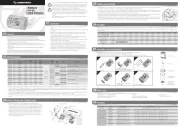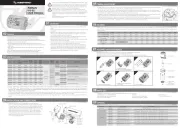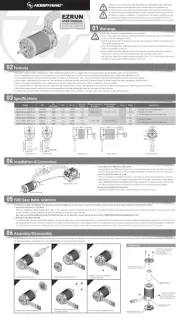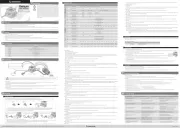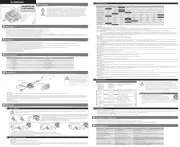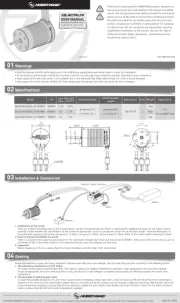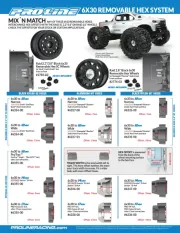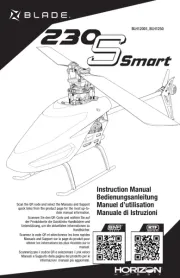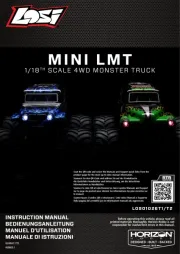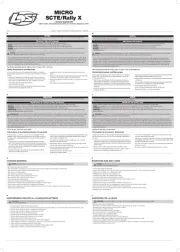
Form 1: Parameter List of QuicRun-WP16BL30 and QuicRun-WP10BL60:
(Italics in the form below indicate factory defaults)
Form 2: Parameter List of QuicRun-WP-8BL150
(Italics in the form below indicate factory defaults)
Option 2 Option 3 Option 4 Option 5 Option 6 Option 7 Option 8 Option 9
2.6V/Cell 2.8V/Cell 3.2V/Cell 3.4V/Cell3.0V/Cell
Level 5 Level 6 Level 7 Level 8 Level 9Level 4Level 3Level 2
0.00 deg 3.75 deg 7.50 deg 15.00 deg 18.75 deg 22.50 deg 26.25 deg11.25 deg
2S LiPo 3S LiPo 4S LiPo 5S LiPo 6S LiPo
Option 2 Option 3 Option 4 Option 5 Option 6 Option 7 Option 8 Option 9
2.6V/Cell 2.8V/Cell 3.2V/Cell 3.4V/Cell3.0V/Cell
Level 5 Level 6 Level 7 Level 8 Level 9Level 4Level 3Level 2
0.00 deg 3.75 deg 7.50 deg 15.00 deg 18.75 deg 22.50 deg 26.25 deg11.25 deg
Note 1: Fwd=Forward, Rev=Reverse, Brk=Brake
Note 2: When set to the “Auto-identification” mode, the battery pack can only be identified as 2S, 4S and 6S Lipo. Because the
normal voltage of each LiPo cell varies from 2.6V to 4.2V, it’s not easy to correctly calculate the cell count of a discharged LiPo
battery pack. Therefore, we strongly suggest you set the “LiPo Cells” manually.
In order to make sure the ESC fits the throttle range of your transmitter, you must calibrate it when begin to use a new ESC, or a used transmitter if some of its settings have been changed,
like the Throttle Trim, D/R, EPA or other parameters. Otherwise, the ESC cannot work properly. Besides, we strongly recommend users to enable the “failsafe” function of the transmitter, set
the “F/S” of the throttle channel to the Shutdown mode or set the protection value to the neutral position, so the car can be stopped if the receiver fails to get the radio signals from the
transmitter. Please calibrate the throttle range according to the following steps.
Model QuicRun-WP-16BL30 QuicRun-WP-10BL60
Peak Current / Resistance
Sensorless Brushless Motor (compatible with sensored motor but not in sensored operating mode)
1:18 & 1:16 On-road / Off-road / Buggy / Monster 1:10 On-road / Off-road / Buggy / Monster
Battery 4-9 Cells NiMH, 2-3S Lipo 4-9 Cells NiMH, 2-3S Lipo
9-18 Cells NiMH, 3-6S Lipo
For 2S Lipo or 6 cells NiMH:
2435-size or smaller motor with the KV<8000
2. Off-road / Buggy / Monster:
2435-size or smaller motor with the KV<5000
For 3S Lipo or 9 cells NiMH:
2435-size or smaller motor with the KV<5500
2. Off-road / Buggy / Monster:
2435-size or smaller motor with the KV<3500.
For 2S Lipo or 6 cells NiMH:
3656-size or smaller motor with the KV<6000
2. Off-road / Buggy / Monster:
3656-size or smaller motor with the KV<4000
For 3S Lipo or 9 cells NiMH:
3656-size or smaller motor with the KV<4000
2. Off-road / Buggy / Monster:
3656-size or smaller motor with the KV<3000.
For 4S Lipo or 12 cells NiMH:
4274-size or smaller motor with the KV<3000
For 6S Lipo or 18 cells NiMH:
4274-size or smaller motor with the KV<2400
• Water-proof and dust-proof for all-weather races;
(Note: please uninstall the cooling fan before using this ESC in water; Clean and dry it soon after the
use for avoiding the connectors get rusty.)
• External programming port, easy to connect to the Program Card when setting the ESC;
• Proportional brake with 4 steps of maximum brake force adjustment and 8 steps of drag brake force adjustment;
• 9 steps of acceleration(punch) adjustment from “soft” to “Very aggressive” to fit for different kinds
of models, tires and tracks;
• Multiple protections: Low voltage cut-off protection / Over-heat protection / Throttle signal loss
protection / Motor lock-up protection;
• One-button(the “SET” button on the ESC) to set the ESC, and easy to reset all parameters to the
factory default settings;
• Compatible with the optional device-the portable Digital LED Program Card, especially convenient
Begin to Use a New Brushless ESC
Congratulations and thanks for purchasing HOBBYWING electronic speed controller
(ESC). The brushless power system for RC model can be very powerful and dangerous,
so please read this manual carefully. Since we have no control over the installation,
application, use or maintenance of this product, in no case shall we be liable for any
damages, losses or costs. Besides, we have the rights to change the design,
appearance, functions and operational requirements without any notifications.
Program the ESC with the SET Button
Set the ESC by the Program Card
• In the programming process, the motor will emit “Beep” tone while the LED is
• If the “N” is bigger than the number “5”, we use a long time flash and long
“Beep—” tone to represent “5”, so it is easy to identify the items of the big
For example, if the LED flashes as the following:
“A long time flash + 1 short time flash” (Motor sounds “B—B”) = the No. 6 item
“A long time flash + 2 short time flash” (Motor sounds “B—BB”) = the No. 7 item
“A long time flash + 3 short time flash” (Motor sounds “B—BBB”) = the No. 8 item,
The Program Card is optional equipment which
needs to be purchased separately. It has 3 digital
LEDs to display the programmable items’ number
(Please refer to the user manual of the program card
The QuicRun-WP10BL60 and QuicRun-WP8BL150 can only be connected to the
program card via the external programming port.
a) When the throttle stick is in the neutral range, neither the Red LED nor the Green LED lights up;
b) When the car moves forward, the Red LED solidly lights; the Green LED also lights up when the throttle stick is at the top position (100% throttle);
c) When the car brakes, the Red LED solidly lights; the Green LED also lights up when the throttle stick is at the bottom position and the maximum brake force is set to 100%;
d) When the car reverses, the Red LED solidly lights; the Green LED also lights up when the throttle stick is at the bottom position and the maximum reverse force is set to 100%.
Check the LED Status in Normal Running
Explanation for the Beep Sound
In normal case, when the ESC is switched on, the motor will emit several “Beep” tones to express the cell count of the battery pack. For example, “Beep-Beep-” means 2S LiPo,
“Beep-Beep-Beep-” means 3S LiPo, “Beep-Beep-Beep- Beep-” means 4S LiPo.
Trouble(s) Solution(s)Possible Causes
No battery voltage is input to the ESC. The switch of the ESC is damaged
The voltage of the battery pack is not in the normal range,
it’s too high or too low.
The throttle signal wire is oppositely inserted or into the incorrect channel.
The wire connections between the ESC and the motor need to be changed.
Low voltage cutoff protection (Red LED blinks)
Overheat protection (Green LED blinks)
The throttle neutral point drifts to the brake area.
The connections between motor and ESC are not reliable.
Check the connections between the battery and the ESC, re-solder the connectors if needed.
Check the voltage of the battery pack.
Plug the signal wire (Rx lead) correctly into the throttle channel (usually Channel #2) of the receiver.
Swap any two wire connections between the ESC and the motor.
Check the battery voltage. If still has some capacity, lower the cut-off threshold voltage;
if not, replace a new battery.
Wait several minutes to cool the ESC. Increase the gear ratio or the T number (Turns) of the motor.
Calibrate the throttle neutral point again to ensure that no LED lights when the throttle stick is
Check all the solder joints and ensure they are well soldered. Check connectors.
Contact the distributor for after-sales service.
After power on, motor doesn’t work but emits “beep-beep-, beep-beep-”
alert tone. (there’s 1 second pause between 2 “beep-beep-”).
After power on, the Red LED turns solid red but the motor doesn’t work.
Turn on the switch, no LED lights up, and neither the motor nor fan works.
The car runs backwards when accelerating forward on radio.
The motor stutters, and cannot start up.
The vehicle can go forward but cannot reverse.
The car suddenly slows down, then stops about 15 seconds later.
Red LED flashes once, choose "0%"
Red LED flashes twice, choose "5%"
Red LED flashes 3 times, choose "10%"
Red LED flashes 4 times, choose "20%"
Red LED flashes 5 times, choose "40%"
Red LED flashes 6 times, choose "60%"
Red LED flashes 7 times, choose "80%"
Red LED flashes 8 times, choose "100%"
Red LED flashes once, choose "None"
Red LED flashes twice, choose "2.6V"
Red LED flashes 3 times, choose "2.8V"
Red LED flashes 4 times, choose "3.0V"
Red LED flashes 5 times, choose "3.2V"
Red LED flashes 6 times, choose "3.4V"
Red LED flashes once to choose
Red LED flashes twice to choose
Red LED flashes 3 times to choose
"Forward / Reverse with brake"
Hold SET key for 3 seconds
Hold SET key for 3 seconds
Hold SET key for 3 seconds
Hold SET key for 3 seconds
......The following steps are just like the above setps......
Finish programming, switch off the ESC, and then switch it on
1. Running Mode: With “Forward with Brake” mode, the car can go forward and brake, but cannot go backward, this mode is suitable for competition; “Forward / Reverse with Brake” mode provides backward function, which is suitable for daily training.
Note: “Forward/Reverse with Brake” mode uses “Double-click” method to make the car go backward. When you move the throttle stick from forward zone to backward zone for the first time (The 1st “click”), the ESC begins to brake the motor,
the motor speeds down but it is still running, not completely stopped, so the backward action is NOT happened immediately. When the throttle stick is moved to the backward zone again (The 2nd “click”), if the motor speed is slowed down to
zero, then the backward action will happen. The “Double-Click” method can prevent mistakenly reversing action when the brake function is frequently used in steering. By the way, in the process of braking or reversing, if the throttle stick is
moved to forward zone, the motor will run forward at once. “Forward/Reverse” mode uses “single-click” method to make the car reverse. When moving the throttle stick from neutral zone to backward zone, the vehicle reverses immediately,
so this mode is usually used in rock crawling.
2. Set the amount of drag brake applied at neutral throttle to simulate the slight braking effect of a neutral brushed motor while coasting.Drag Brake Force:
3. Low Voltage Cut-Off: The function mainly prevents the Lipo battery from over discharging. The ESC detects the battery voltage at any time, if the voltage is lower than the threshold for 2 seconds, the output power will be reduced 70%,
after 15 seconds the output power will be completely shut off and the red LED flashes in such a way: “ -, -, -”. Please stop your car at the track side as soon as possible to avoid obstructing other racing cars.☆☆☆
Note: For NiMH battery, if the voltage of the whole NiMH battery pack is higher than 9.0V, it will be considered as a 3 cells Lipo battery pack; If it is lower than 9.0V, it will be considered as a 2 cells Lipo battery pack. For example, if a NiMH battery
pack is 8.0V, and the threshold is set to 2.6V/Cell, so it will be considered as a 2 cells Lipo battery pack, and the low-voltage cut-off threshold for this NiMH battery pack is 2.6x2=5.2V.
4. Start Mode (Also called “Punch” or “Acceleration”): Level 1 has very soft start acceleration, while level 9 has very quick start acceleration. From Level 1 to Level 9, the start force is increasing. If you choose “Level 7” to “Level 9”, you should use good
quality battery with powerful discharge ability, otherwise you cannot get the burst start effect as you want. If the motor cannot run smoothly (the motor is cogging), sometimes it is caused by the weak discharge ability, please use a better
battery or increase the gear ratio.
5. The ESC provides proportional brake function. The brake force is related to the position of the throttle stick. Maximum brake force refers to the force when the throttle stick is located at the top point of the backward Maximum Brake Force:
zone. A very large brake force can shorten the brake time, but it may damage the gears.
6. Sets how much power will be applied in the reverse direction.Maximum Reverse Force:
7. Initial Brake Force: It is also called “minimum brake force”, which refers to the force when the throttle stick is located at the initial position of the backward zone. The default value is equal to the drag brake force, so the brake action can be very smoothly.
8. This setting adjusts the width of the neutral range.Throttle Neutral Range:
9. This function can be used to fine-tune the output power of the motor, the bigger the timing, the faster the motor runs or the larger output power of the motor. As the Boost Timing technology has been introduced into this ESC, so Timing:
under the sensored mode, adjust the ESC timing can greatly increase the motor RPM. Therefore, please remember to enlarge the gear ratio of the chassis and carefully check temperatures of the motor and the ESC after increasing the timing.
10. If this function is activated, the output power will be cut off when the temperature is higher than the factory-preset value for 5 seconds. When the protection happens, the Green LED will flash in such a way “ -, -, -” .Over-Heat Protection: ☆ ☆ ☆
11. Motor Rotation: Face to the motor shaft (that means the endbell of the motor is far from your face), and move the throttle stick to forward zone. If this programmable item is set to “CCW”, the shaft runs counter-clockwise; if it is set to “CW”, the
12. We strongly suggest you set the “Cell Count” manually instead of using the “Auto-identification” mode.Cell Count:
Reset All Items to Default Values
At any time when the throttle is located in neutral zone (except in the throttle calibration or parameters program process), press and hold the “SET” key for over 3 seconds, the red LED and green LED will flash
simultaneously , which means each programmable item has be reset to its default value. The ESC needs to be restarted to complete the reset process.
Click the SET button to choose the
option, the times the red LED
blinks indicates the option number
Press SET key to choose the value,
the flash times of the RED LED
(Once means the 1st option,
twice means the 2nd option, etc.)
Brushless Electronic Speed Controller
keeping all the wheels in
1. Turn on the transmitter, and set parameters (of the throttle channel) like “D/R, “EPA”, “ATL” to 100% (if there is no LCD display
on the transmitter, please adjust the corresponding knob to its limit). Set the throttle trim to 0 (if there is no display, then adjust the
knob to the neutral position). For FUTABA
and similar transmitters, set the throttle direction to “REV”, while the throttle direction
of others to “NOR”. Please disable the built-in ABS brake function in your transmitter.
2. Hold the SET button while sliding the switch to the ON position, and then release the “SET” button the moment when the Red
LED starts to blink. (If you don’t release the SET button in 3 seconds, the ESC will enter the program mode, in such a case, please
switch off the ESC and re-calibrate the throttle range again from Step 1.)
Move the throttle stick to the neutral position and press
Set the 3 points according to pictures
• The neutral point. • The end point of the forward direction. • The end point of the backward/brake direction.
When the process of calibration is finished, the motor can be started after 3 seconds.
Move the throttle stick to the end position of forward
and press the set button.
Move the throttle stick to the end position of forward
and press the setup button.
Electronic Speed Controller
